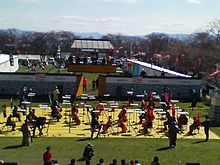Human chess
This article needs additional citations for verification. (August 2011) |



Human chess, living chess or live chess is a form of chess in which people take the place of pieces. Human chess is typically played outdoors, either on a large chessboard or on the ground, and is often played at Renaissance fairs.
In Vietnam, human chess is one of the folk games that take place during folk festivals of in general and the Northern Delta in particular, especially during the Lunar New Year of the nation. Human chess is actually a chess game where people act as chess pieces. Playing human chess often gathers a large number of spectators, but all must try to keep quiet so that the players are not scattered.
Forms[edit]
Many human chess games are choreographed stage shows performed by actors trained in stage combat. When this is the case, piece captures are represented by choreographed fights that determine whether the piece is actually taken or not. Alternatively, the pieces may spar, following rules similar to those used by the Society for Creative Anachronism.
Instances[edit]
A costumed human chess game has been staged every two years on the second week in September in the Italian city of Marostica, near Venice, since 1923. The game commemorates a legendary chess game played in 1454 by two young knights in order to settle which of them would court the lady that both had fallen in love with. The event lasts 3 days. The participants of the game dress in historic clothes. The human chess game has strict rules which have been set by a specific committee. The performance lasts 30 minutes.[1]

In terms of the Japanese game of shogi, an annual festival in Tendō, Yamagata held every late April has an event called Ningen Shōgi (人間将棋), where people involved alongside large shogi pieces with stands are dressed in Sengoku period costumes.[2] Tendō and Marostica have been sister cities since 1993.
In xiangqi, human chess is a tradition in Vietnam, where it is called cờ người, and is a feature at many Vietnamese village and temple festivals.[3]
Fictional representations[edit]
Human chess is a theme in Lewis Carroll's Through the Looking-Glass (1871).[4]
The Chessmen of Mars depicts a version of a Martian chess variant called Jetan where the pieces are human captives and captures in the game are replaced by fights to the death between them.
In Land of the Giants 2/4 "Deadly Pawn", an insane Chessmaster uses the little people as live chess pieces; if they can't escape, they are either turned over to the SIDE or killed.
Harry Potter and the Philosopher's Stone features a game of Wizard's chess with magically animated human-sized pieces. The characters Harry, Ron, and Hermione take the place of three of the pieces.
Hunters featured a game of human chess played at a concentration camp during WWII. This was criticized by the Auschwitz Museum since such a game never actually took place.[5]
Episode "Checkmate" of The Prisoner features the protagonist in such a chess match.
The part "Chess" of Tales of the Unusual features a human chess game that the main protagonist is forced to play. Eliminated human chess pieces seem to be killed, but it is revealed in the end that all kills and all deaths are faked.
References[edit]
- ^ WhereMilan. "The Human Chess Game in Marostica - September 2018 [Less than 250Km from Milan]". Where Milan. Archived from the original on 2020-03-03. Retrieved 2020-03-03.
- ^ "Tendo Ningen Shogi".
- ^ "Human chess (Co nguoi), a funny traditional game - Vietnam Tourism Information".
- ^ Stamp, Jimmy. "The 64-Square Grid Design of 'Through the Looking Glass'". Smithsonian Magazine. Retrieved 19 March 2020.
- ^ "Amazon drama 'Hunters' criticized by Auschwitz Memorial Museum". EW.com. Retrieved 2020-03-03.
External links[edit]
- Life-sized chess games in urban settings
- AnimeBoston.com Cosplay Human Chess game
- Photos of Anime Boston 2007 cosplay chess
- Animeiowa 2008–2009 anime-themed human cosplay chess[permanent dead link]
- AnimeNEXT's Cosplay Human Chess
- RIT Cosplay Troupe official website
- "George Henry Mackenzie vs Eugene Delmar - New York 1879 (An example game of Human Chess from 1879)". Chessgames.com. Retrieved May 9, 2013.
